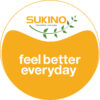A stroke is a medical condition that calls for one to seek medical attention as soon as possible. The term “Early Stroke Symptoms’ plays an important role, mainly because it can mean the difference between life and death partially due to the readiness of the response. At Sukino Healthcare we emphasize the role of awareness in detecting these signs because the critical time is when dealing with a stroke. Learning them and being able to identify them can be critical to a person being able to walk for the rest of his or her life. In this article, we will discuss the main signs that a person should be aware of to promptly respond to the occurrence of a stroke.
What is a Stroke?
A stroke is a medical condition that happens when the blood supply to a part of the brain is reduced or stopped entirely. In as much as it may take five to twenty minutes of oxygen deprivation, brain cells begin to die. Strokes can lead to brain damage, disability or even death if this condition is not attended to on time. There are two primary types of strokes: ischemic, which occurs due to the obstruction in the blood artery, and hemorrhagic, the one that occurs due to the rupture of blood vessels. Both are often fatal, and urgent medical assistance should be provided in these cases.
Why Recognizing Early Stroke Symptoms is Crucial
It is therefore imperative that people identify “Early Stroke Symptoms”. Given that this is a medical emergency, time is always an important factor with some writers referring to the treatment of stroke as the “golden hour”. The symptoms of stroke should promptly be detected and acted upon since this facilitates a decreased chances of the victims living with a disability or even death. Similarly, most people complain of weak or no symptoms and end up neglecting treatment leading to severe effects. Therefore, the knowledge of these symptoms and immediate action is crucial.
Common Early Stroke Symptoms
1. Sudden Numbness or Weakness in the Face, Arm, or Leg
Another easily recognisable sign that may indicate a stroke is the sudden onset of numbness or weakness, especially on one half of the face, arm or leg. Some of the symptoms may include a drooping face, inability to lift one’s arm, or weakness that suddenly sets in one leg. The symptoms mainly do not cause discomfort and some people disregard them. However, this numbness or weakness should be taken very seriously, as it means that part of the brain is left without a blood supply. Emergency response is vital, and calling an ambulance can help in preventing more harm to the brain.
2. Confusion, Trouble Speaking, or Understanding Speech
A stroke can affect important language-related areas of the brain and cause a person to suddenly become confused, have trouble with speaking, or understanding others. The symptoms range from slight slurring of speech to not being able to speak at all. Sometimes, the person may not realize that he or she is confused, which is why it is important for others to notice such signs. This type of impediment shows that the stroke is perhaps touching the region in the brain that controls language, and this calls for immediate attention with efforts to minimize the damage.
3. Sudden Vision Problems
Another early sign of stroke is the loss of vision in one or both eyes or the sudden experience of blurred vision, the appearance of double vision, or even the complete loss of vision. These operations affect vision and can be abrupt or gradual, and they may be either temporary or permanent. They may involve one eye or both and vary in severity. Blindness and vision disturbances in the course of a stroke are rooted primarily in the injury to the occipital lobe. The need for early medical intervention as the condition worsens if not treated on time increases the odds of healing greatly.
4. Dizziness, Loss of Balance, or Coordination
Strokes may alter how the brain controls body movements and cause sudden dizziness, loss of balance or difficulty in walking. These symptoms are often just regarded as clumsy movements or tiredness, but if the patient develops such symptoms abruptly, it is a clear sign of a stroke. Some patients may experience loss of coordination and balance, which makes it challenging to stand, walk or even sit. This should be considered as a medical emergency if accompanied by other symptoms, and appropriate measures should be taken to visit a doctor.
5. Sudden Severe Headache
A sharp headache that begins from nowhere could be a sign of a stroke, especially the hemorrhagic stroke where a blood vessel in the brain has burst. This type of headache is commonly referred to as the worst headache of one’s life, and may further be characterized by nausea, vomiting or changes in consciousness. This is not like a headache; it is acute, and the onset is usually very abrupt. In this type of stroke, it is important to seek medical help as soon as possible because the condition can progressively worsen and cause irreversible brain damage or death.
6. Sudden Difficulty Swallowing
Speaking and swallowing problems are common early-warning signs of stroke and are categorised as dysphagia. This is seen as Swallowing muscles get paralyzed or become weak, such that the patient struggles to swallow both the thickened foods and fluids, or even saliva. Dysphagia may result in choking or aspiration that is, the accidental swallowing of food or liquids into the respiratory tract. This symptom poses a great risk since it might lead to pneumonia or other respiratory complications if neglected. Work with a physician is necessary in order to prevent the worsening of this condition or the development of other health issues.
The Importance of FAST: Face, Arms, Speech, Time
The FAST approach is a quick method to rehearse the initial warning signs of a stroke and what to do if you observe somebody might be having one. Here’s what FAST stands for:
- F – Face: Ask the person to smile. Does one side of the face droop?
- A – Arms: Ask the person to raise both arms. Does one arm drift downward?
- S – Speech: Ask the person to repeat a simple phrase. Is their speech slurred or strange?
- T – Time: If you observe any of these signs, it’s time to call emergency services immediately.
By following the FAST protocol, a possible stroke will be immediately recognized and the affected person will be taken to hospital as soon as possible. This can help to enhance the probability of the healing process and decrease the possibility of obtaining a severe outcome.
Risk Factors for Stroke
It is also believed that the knowledge of risk factors contributing to stroke can help in the identification of early signs of stroke. Examples of the potential risk factors are hypertension, diabetes, tobacco use, obesity, and lack of physical activity. Other risk factors include age, gender and family history as part of the factors that can lead to the development of the condition. Controlling these risk factors can decrease your chances of having a stroke through diet, drugs, and physical checkups.
What to Do If You Suspect a Stroke
Any time that you feel someone might be having a stroke then it is very important to act fast. Contact emergency services at once and stick to the mnemonics known as ‘FAST’. Do not wait if they are going to disappear one their own accord. Every minute lost is a minute gained by the enemy. If help is not immediately available, keep the person as comfortable as possible and help them remain as calm as possible and in a safe position. Keep them away from food, drink, or any form of medication unless prescribed by a doctor.
Conclusion
Awareness of the “Early Stroke Symptoms and the nature of the problem can help save many individuals. The earlier the condition is recognized and treated, the better prognosis will be to have minimal impairment after the stroke. As a healthcare provider at Sukino Healthcare, we want people in our community to be knowledgeable and take prompt action when dealing with strokes for optimal results. Please be sure to note that early identification of early signs, and taking appropriate action greatly determine the outcome. Be aware, be alert, and seek help if you are affected by any of these signs.
Thus, our concept map on ‘Early Stroke Symptoms’ and a call to seek medical help as soon as possible will help minimize the effects of a stroke. By recognizing such signs and intervention, one is more likely to witness a positive outcome for a friend or family.
We are India’s first comprehensive continuum care provider. We provide multidisciplinary out of hospital care to acute and post-acute and chronically ill patients at our critical care facilities and your home.


